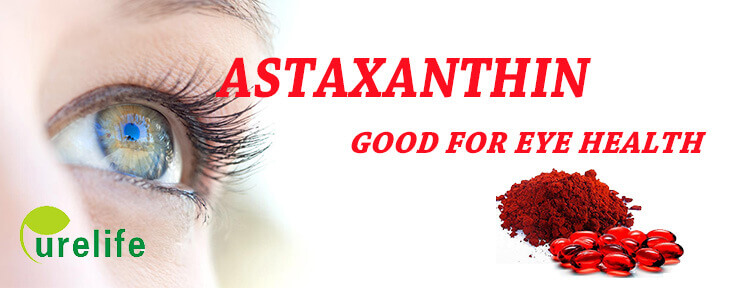Astaxanthin is good for eye health
What is Astaxanthin
Astaxanthin is a powerful, naturally occurring carotenoid pigment that’s found in certain marine plants and animals. Often called “the king of the carotenoids,” astaxanthin is recognized as being one of the most powerful antioxidants found in nature. Nowadays, more and more people realize that astaxanthin is good for eye health

Astaxanthin sources
Astaxanthin exists in aquatic animals such as salmon, trout, krill, shrimp, crayfish, and crustaceans. The microalgae Haematococcus pluvialis which grows in fresh water throughout the world is the richest natural source of astaxanthin. Also, Astaxanthin can be synthesized .We can find that on the market, synthetic and microbial fermented Astaxanthin are much cheaper , but both effect on people is very limited , because human body absorbs L- Astaxanthin only , while only Haematococcus pluvialis astaxanthin contains 100% left-hand astaxanthin . Fermented Astaxanthin is “R-”
Astaxanthin is good for eye health
As we age, environmental pollution and big life stress, our eye health is under threat.
Too much exposure to sunlight or high levels of oxidation can lead to free radicals being abundant in our eyes. A condition called ischemia, which prevents our eyes from getting nutrients and oxygen, is a common cause of increased oxidation in the eyes. Another reason is that the ischemia barrier is removed. The reoxidation of the tissue after the barrier is removed is called reperfusion. Even normal enzymatic processes lead to an increase in free radicals and singlet forms of oxygen such as hydrogen peroxide, peroxides and hydroxides in the eye.
Free radicals and singlet oxygen will oxidize the polyunsaturated fatty acids in the retina, which will damage the membrane function of the retina, and eventually cause temporary or permanent damage to the retinal cells. Once the retina is damaged, it cannot be repaired. Therefore, the antioxidants that penetrate the blood-brain barrier and the blood-retina barrier are crucial because they protect the eye from such damage. Lutein and zeaxanthin are well-known nutrients for eye health and have been shown to help prevent age-related macular degeneration and other degenerative conditions. Astaxanthin has the same benefits for eye health because of its superior antioxidant and anti-inflammatory properties.
Astaxanthin can cross the blood-brain barrier
Eyes usually contain lutein and zeaxanthin, but don’t contain astaxanthin. Dr Mark Tso in the University of Illinois did a research. He was the first to demonstrate that astaxanthin can cross the blood-brain barrier and the blood-retinal barrier by testing astaxanthin levels in the eyes of rats. As expected, he found no astaxanthin in rat eyes first time, then he retested the rats that had been fed with astaxanthin, and this time, astaxanthin was detected in rat retinas. Mark verified that astaxanthin can cross the blood-brain barrier into the brain, and then it travels through the blood-retina barrier to the retina and macula.
After a series of extensive tests, Mark further demonstrated that astaxanthin has more protective effects when it enters the eye, preventing the following harms:
. Light damage
. Photoreceptor cell damage
. Nervous ganglion cell damage
. Neuronal damage
. Inflammatory damage
Astaxanthin can relieve eyestrain
At present, eye fatigue is a serious problem that many people have. Using cellphone, computer or and other electronic equipment long hours can lead to various visual problems such as eye fatigue, blurred vision, and double vision.
A double-blind study was done in Japan: intake 5 mg of astaxanthin( extracted from Haematococcus pluvialis) for four weeks, 46 % of the subjects had reduced their eyestrain . Another group of Japanese clinical studies also found similar results, this double-blind study focused on the effects of astaxanthin on eye fatigue and visual regulation: 40 subjects in total were divided into two groups, one group took astaxanthin at a dose of 6 mg per day for four weeks. The results showed that the astaxanthin group showed significant improvement in three separate visual parameter values. Other studies have also tested this work, it suggests that intake 6 mg of astaxanthin per day for four weeks can relieve eyestrain such as eye soreness, eye dryness, eye fatigue and blurred eyes.

So how does astaxanthin work on the eyes? Astaxanthin function mechanism includes: improve retinal blood flow, inhibit eye inflammation and regulate visual acuity. Getting adequate blood flow to the eyes and retina is very important for the eye health, and clinical trials have shown that astaxanthin improves capillary blood flow in the retina, making blood flow easier, with better blood flow, the lens adjustment is more flexible and simple, which relieves eyestrain improves the ability of eyes to focus.
As a powerful antioxidant, astaxanthin is able to cross the blood retinal barrier, protect the retina of the eye from oxidative damage, and stave off macular degeneration.
Astaxanthin dosage for eye health
Generally 2-5mg per day is good, and 10-15mg daily will be a better effect. But please discuss with your physician and ask him/her about the suitable dosage


